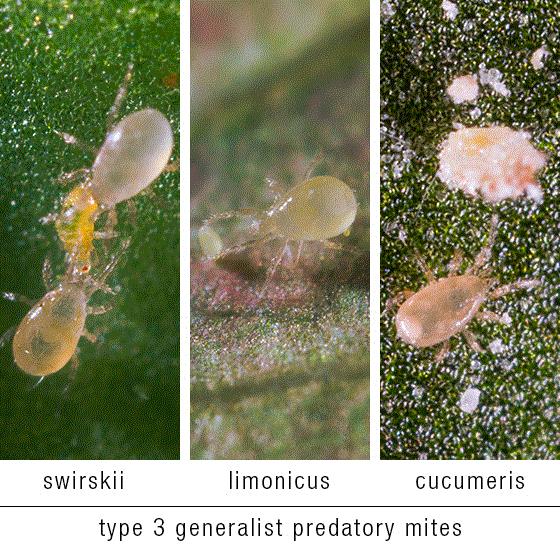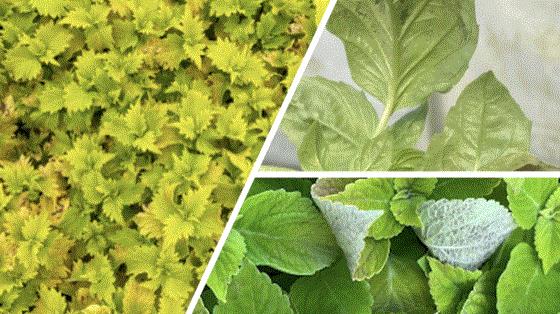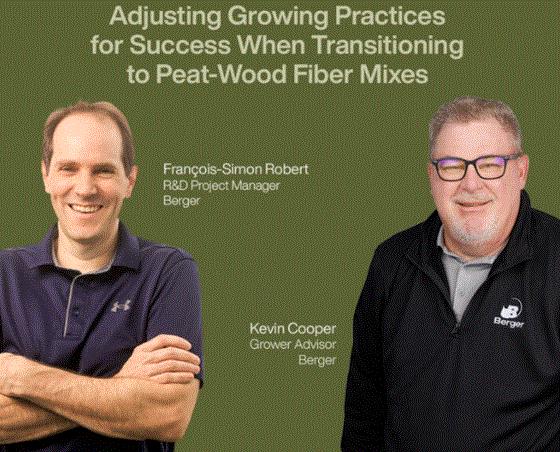NEW VIDEO MINISERIES: Finished Petunia Production
A few weeks ago, I recorded three videos with Dr. Will Healy covering finished petunia culture. We were planning one video discussing seed petunias, because the recently retired Ball Seed culture manager has been on a roll with top seed crops, and petunias were next on the list.
As we got to thinking about it, we decided to break petunias down into three categories, because although many of the best practices are the same or similar, there are plenty of nuances depending on which type of petunias you produce. Finishing "common" seed petunias from plugs (think multiflora and grandiflora pack types) require certain production protocols, while Wave spreading types are a bit different. Then, while Will was on the petunia train, he put together information on vegetative petunias, as well.

So, we decided to break out three presentations—recorded back to back to back in a marathon session—to share with growers as a 3-part miniseries that should cover just about all you need to know to ship top-notch petunias to your wholesale customers.
I don’t need to explain how important petunias (seed, veg, single, double, Wave, novelties) are for our industry but let’s just say they’re on the Mount Rushmore of garden plants. And for good reason. They cover all colors of the rainbow and are versatile for just about any use in landscapes, containers, baskets and more. But maximizing sales and minimizing losses requires care and attention, and that’s the info Will brought to the table. He’s worked with growers around the world producing millions and millions of petunias, and he has the recipes for success.
Many of the differences between common, Wave and vegetative lie in the nutrition/fertility, growth regulation, lighting and disease control and Will addresses each stage of the game individually. There’s plenty of crossover in the presentations, but we thought different growers (with different crop mixes) would choose the most applicable video … hence three individual episodes.
Here are the links:
As always, these three videos are also available for you to listen to on the go! Be sure to subscribe to the Tech On Demand podcast on your favorite app so you never miss an episode. And if you’re not a regular listener, jump back into the archives and get caught up—there are 176 episodes as of today.

Koppert Corner: Which Mite is Right?
While choosing a type 1 or 2 predatory mite species to manage spider mites is fairly straight forward, choosing which type 3 generalist thrips predatory mite species to use against western flower thrips (WFT) is more nuanced—a decision based on several factors:
-
Target thrips species
-
Growing temperatures
-
Crop value

Target Thrips Species
If Thrips parvispinus is your target, you need the most aggressive predatory mite species available. Limonica (Amblydromalus limonicus) has been proven to be the most effective predatory mite against T. parvispinus, with Swirski (Amblyseius swirskii) a close second. Is western flower thrips (WFT) your target? With WFT, more choices become available based on growing temperatures and crop value.
Growing Temperatures
When targeting WFT in spring annuals crops grown cool (less than 68F average daily temperature), a basic type 3 predatory mite such as Thripex (Neoseiulus cucumeris) is the mite of choice. As daylength increases and temperatures warm in late spring and into the summer months, a changeover to Swirski, a warm-season predatory mite, is recommended. Why Swirski for summer? Because she remains highly active in summer’s heat and humidity and can reproduce at temperatures north of 90F. Is Thripex always the best choice for cool-season growing? Not necessarily—it depends on crop value.
Crop Value
Growers producing high-value seasonal flowering crops for Valentine’s Day, Easter, and Mother’s Day (this includes perennials) have little tolerance for thrips damage on flowers or foliage. This is a job for an aggressive predatory mite species with reproductive capabilities and an appetite that extends beyond WFT. Anso-Mite (Amblyseius andersoni) or Limonica are perfect for cool-season florist crops such as cyclamen, primula, cineraria and ranunculus, where average daily temperature is typically well below 68F. Swirski performs best in flowering potted crops grown warm throughout the year—think florist mums, gerbera and ornamental peppers.
WARNING: Avoid releasing more than one type 3 predatory mite species on a crop at once. They are antagonistic and fight each other as much as they hunt their prey, which cuts deeply into their efficacy. Pick one and run with it; don’t apply two.
Choosing the best biosolutions can be challenging. Technical experts at Koppert are always more than happy to discuss your crops and desired outcomes and help determine the best choice of type 3 predatory mite for your greenhouse.

Nick’s Tip of the Week: Don’t Get Down in the Downy Mildew Dumps (Part 1)
Each week, I’ll work with my buddy Nick Flax, a technical services expert at Ball, to share a concern that’s come up during one of his numerous calls with growers across North America. This week he’s kicking off a two-part tip on downy mildew, a problem the Tech On Demand team helps growers deal with every year. This week, he’ll share ID and life cycle info. Next week will be all about management strategies and useful resources.
PROBLEM: It’s that time of year again! When the weather starts to turn and warm temperatures begin to spike, growers start to send me photos of plants with suspicious symptoms and ask, “Does that look like downy mildew to you?” Thankfully, many of these have been false alarms so far this spring, but it’s only a matter of time until our disease diagnostic lab at Ball starts to confirm DM cases around North America.

NICK’S TIP: As a group, downy mildew-causing pathogens are difficult to detect, they strike fast and can quickly develop resistance to fungicides. Exclusion is not possible in most cases, so it is critical to scout regularly for disease symptoms and signs, understand their life cycles, and establish a culture of prevention to avoid costly losses for you and your customers.
Downy Mildew Identification
Disease symptoms vary from crop to crop, but mottling and mild chlorosis on lower leaves are often the earliest visible symptoms. It is easy to mistake this for any number of mineral nutrient deficiencies, so many growers overlook this early warning sign. Oftentimes, the whiteish or grayish dusty spore clusters on the undersides of infected leaves are what we find when scouting our crops. Unfortunately, by the time these symptoms and signs appear, it’s often too late for the crop. As disease progresses, infected areas become necrotic and affected foliage dies.
-
In most cases, downy mildews will cause total collapse of plants they infect.
-
While some DMs don’t spread aggressively in a systemic manner through their host, they quickly produce additional spores and reinfect other healthy parts of the plant.
Understand the Downy Mildew Life Cycle
When a grower finds DM in their greenhouse, the first question I often get is, “where did it come from?” Part of the challenge with this group of pathogens is… it depends. The term “downy mildew” encompasses multiple genera of organisms and many species within each genus. While there are similarities among many of these organisms, nuances between each dictate where the initial infection occurs and how to best prevent it. For practical purposes, DMs can produce two types of spores:
Sporangia—the dusty-colored “fuzzies” found on the undersides of leaves of infected plants.
-
Though they’re often short-lived and can remain viable for hours to days at a time after they are produced (depending on the species), these spores spread via splashing water and can travel long distances on air currents to infect a new host.
-
These spores can reinfect healthy parts of their host plant and spread to adjacent, susceptible crops in your greenhouse.
-
All DMs reproduce via this asexual spore life stage.
Oospores—often called “resting spores” or “survival spores,” these durable structures can survive in soil, plant debris and water for years at a time.
-
When a susceptible host grows or is planted nearby, these spores can infect through the rootzone or by blowing or splashing up from the ground onto lower leaves of the plant.
-
Notably, Plasmopara destructor (formerly P. obducens), which causes impatiens downy mildew (IDM), produces oospores, but not all DMs do.
Many DMs survive in the landscape in soil or debris of infected plants from the previous season. When weather conditions are right, spores germinate and infect bedding plants or closely related native species and weeds. These infected plants produce more sporangia that spread further via wind to find new hosts.
-
In the greenhouse, these wind-blown sporangia often serve as the initial source of infection in a given season.
-
Some DMs can be seedborne, so it is important to get your seed from reliable sources and know the inherent risks of DM in certain crops before you grow them.
-
It's impossible to keep these tiny assassins from slipping in through your greenhouse vents, so prevention is a must.

STREAMING LIVE MARCH 19! Growing in Peat + Wood Fiber Substrates
Mark your calendar to save the date for an upcoming live stream titled ADJUSTING GROWING PRACTICES WHEN TRANSITIONING TO PEAT/WOOD FIBER MIXES. It’s scheduled for 1 p.m. EST/Noon Central on March 19. You can click the link to register.
 This free GrowerTalks live stream will offer valuable insights about how to transition from a traditional peat-based potting mix to one that combines peat with the new wood fiber blends. Join two of Berger’s horticultural experts as they share best practices for crop culture with peat/wood fiber mixes, including:
This free GrowerTalks live stream will offer valuable insights about how to transition from a traditional peat-based potting mix to one that combines peat with the new wood fiber blends. Join two of Berger’s horticultural experts as they share best practices for crop culture with peat/wood fiber mixes, including:
-
Initial hydration
-
Irrigation strategies
-
Managing dry-down cycles
-
Practical solutions to optimize your growing practices for healthy plant development
The experts joining host Chris Beytes are François-Simon Robert and Kevin Cooper. François-Simon, a Laval University agronomy graduate, is an R&D project manager at Berger, specializing in wood fiber optimization, soft fruit substrates and precision agriculture, with expertise in soil sciences and horticultural production. Kevin is a grower advisor at Berger who brings more than 30 years of industry experience, including head grower, greenhouse owner and technical advisor. With a B.S. in Horticulture from Mississippi State University, Kevin’s extensive knowledge of growing media and horticultural crops gives him a unique set of skills to help today’s greenhouse managers.
Again, here’s the LINK TO REGISTER.

Peat Moss & Tariffs … from Acres Online
Is peat moss an “et cetera”? That’s the headline of a news item Ball Publishing bossman Chris Beytes included in his ACRES ONLINE newsletter earlier this week. I want to share the information again, in case you missed it.

From Chris:
Over the past week or two, I’ve been hearing that some Canadian “agriculture” might get an exemption from President Trump’s proposed 25% tariffs. But what part of agriculture? Might peat moss be included in there somewhere?
I’ve been digging deep online to see what I might find and that’s how I found this Politico article. In it, House Ag Chair G.T. Thompson (R-Pa.) is said to have asked the White House for exemptions for agricultural inputs, as have other GOP lawmakers, including Sen. Chuck Grassley (R-Iowa) and Rep. Zach Nunn (R-Iowa).
The story then quotes Thompson saying, “I absolutely am weighing in [at the White House] … things like potash, nitrogen. I’d throw peat moss in there, too, because that’s important to horticulture and mushroom growers.”
Then I found another quote, this time in a Bloomberg piece, that doesn’t directly say peat moss, but hopefully hints at it:
Agriculture Secretary Brooke Rollins told Bloomberg News that “everything is on the table” and she is “hopeful” that the administration could decide on providing relief for the agricultural sector.
“As far as specific exemptions and carveouts for the agriculture industry, perhaps for potash and fertilizer, et cetera—to be determined,” Rollins said Wednesday at the White House. “We trust the president’s leadership on this. I know he is hyper focused on these communities.”
Further down, the Bloomberg piece also states:
Lawmakers from states with strong agriculture interests have pleaded with the administration to carve out tariff exemptions for fertilizers and other products that are critical for growing U.S. crops.
Hopefully, Mr. Thompson did throw in peat moss at the White House. And that Secretary’ Rollins’ “et cetera”… and “other products” includes peat!

Finish Line …
Yes I’m pretty much repeating myself from last week’s newsletter, because this is important info! Chris Beytes, Jen Zurko, Osvaldo Cuevas and I will be back on the road in Cali in two weeks. Traveling the coast and visiting greenhouses full of show-quality new varieties is always a highlight of my work year, and although the days are long (up at 5:30 a.m. and finally hitting “send” on the newsletters somewhere around 11 p.m. if we are lucky), the people we meet, plants we see and stories we hear are inspiring and energizing.
Perhaps you’re heading to Spring Trials this year? If so, watch for us rolling into greenhouses with notebooks in hand, cameras at the ready and eventually mic’d up and rolling video.
If not, don't worry, because we have you covered in multiple ways. I know it’s a crazy time of year for many in the industry and the travel is impossible, so we produce content that’s available “on demand” whenever you have time to get caught up. The daily newsletter is the best way to follow our journey, and you should be able to read our banter and variety highlights during your morning cup of coffee. If a variety piques your interest, click the video links we share.
Here are three ways to follow us up the California coast from March 24 to 30, reporting on hundreds and hundreds of new varieties from about 30 breeders and product development companies.
Until next week …




Please feel free to send your comments, constructive criticism and topic ideas to me at bcalkins@ballhort.com.

Bill Calkins
Editor - Tech On Demand
This email was received by you and 25,645 other fine subscribers!
If you're interested in advertising in Tech On Demand, contact Kim Brown ASAP and she'll hook you up.